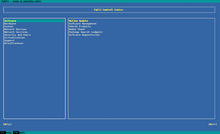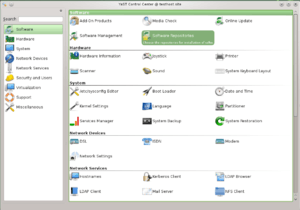YaST
|
YaST logo, an Aardvark | |
|
| |
| Original author(s) | SuSE |
|---|---|
| Developer(s) | SUSE |
| Stable release | 3.0.11 / November 19, 2013 |
| Written in | Ruby[1] |
| Operating system | Linux |
| Type | Operating system setup and configuration tool |
| License | GNU General Public License[2] |
| Website |
en |
YaST (Yet another Setup Tool[3]) is a Linux operating system setup and configuration tool that is featured in the openSUSE Linux distribution, as well as SUSE's derived commercial distributions. It features tools that can configure many aspects of the system. It is also part of the defunct United Linux. The first SuSE distribution that included YaST was released in May 1996. YaST was rewritten in 1999 and included first in SuSE Linux 6.3 as an installer-only. YaST2 was added to the desktop in SuSE Linux 6.4 and co-existed with YaST1 until YaST1's removal in SuSE Linux 8.0.
Details

YaST is free software that SUSE has made available under the GPL.[4] It is a tool for administering and maintaining a SUSE Linux installation. It allows administrators to install software, configure hardware, set up networks and servers, and more.
A feature of YaST is that it contains both GUI and ncurses front ends. This is especially useful for non-GUI installations such as servers, for system administration over slow Internet connections, and for when one is unable to boot into a graphical X server but still requires an advanced user interface to the package manager (for example, a novice user trying to downgrade an Xorg package to fix a graphical installation).
openSUSE 10.3 features a redesigned YaST for GNOME users and openSUSE 11.2 features a redesigned YaST Control Center for KDE. In openSUSE 12.1's KDE version, a YaST specific theme was added that includes a grey background and green buttons.
YaST offers package management functionality through the ZYpp project.[5] The first ZYpp enabled package management YaST applications had performance problems and long start up times, but was improved in the 10.2 and 10.3 releases. Starting with openSUSE 11.0 alpha 3, ZYpp was integrated with the SAT solver project, making YaST and Zypper faster than other rpm based package managers.[6]
YaST used to include SaX and SaX2, the Suse Advanced X configuration. SaX was rewritten as SaX2 in SuSE Linux 6.4. SaX1 was removed in SuSE Linux 8.1 and SaX2 was removed from the YaST Control Center in openSUSE 11.2. SaX2 was removed completely in openSUSE 11.3.
YaST is implemented in the Ruby programming language.[1]
AutoYaST
AutoYaST is a system for installing one or more openSUSE systems automatically without user intervention. AutoYaST installations are performed using a control file with installation and configuration data. The profile of each current system is stored in /root/autoyast.xml.[7]
WebYaST
WebYaST is a web interface for YaST that can be used to check the status of the current machine. It can check on the installation of packages, shutdown or reboot the system, change some system settings (such as the time), and change the status of system services or daemons.[8]
See also
References
- ↑ 1.0 1.1 Larabel, Michael (2013-08-12). "openSUSE 13.1 M4 Brings Ruby-Based YaST". Phoronix. Retrieved 2013-08-13.
- ↑ "File on GitHub". Retrieved 2014-05-14.
- ↑ "YaST2 Resource Page". Retrieved 2008-06-29.
- ↑ "Novell Launches Open Source Systems Management Project". Novell. Retrieved 2008-03-01.
- ↑ "Libzypp". opensuse.org. Retrieved 2008-04-27.
- ↑ "fast package management". duncan.mac-vicar.com. Retrieved 2008-04-27.
- ↑ openSUSE 10.3 Startup. Novell. September 7, 2007. p. 32.
- ↑ Friedl, Jakub. "WebYaST User Guide". Novell. Novell. Retrieved 2014-05-17.

